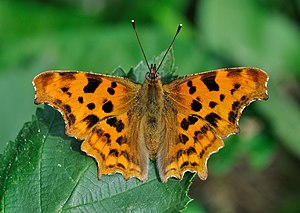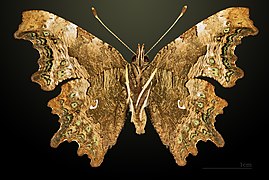C-folder
| C-folder | ||||||||||||
|---|---|---|---|---|---|---|---|---|---|---|---|---|

C-butterfly ( Polygonia c-album ), summer generation |
||||||||||||
| Systematics | ||||||||||||
|
||||||||||||
| Scientific name | ||||||||||||
| Polygonia c-album | ||||||||||||
| ( Linnaeus , 1758) |
The C-butterfly ( Polygonia c-album , syn .: Nymphalis c-album ) is a butterfly (day butterfly ) from the noble butterfly family (Nymphalidae).
description
The C-butterfly reaches a wingspan of 40 to 50 millimeters. The wings are very variable in color. C-butterflies have orange-colored tops that are drawn with a black, brown, and yellow blotch pattern. The undersides of the wings are dark brown, light brown, gray or yellowish in color. What is striking here is the white, C-like pattern that gave the butterfly its name. The moths of the first generation usually have light undersides of the wings, those of the late first and second are rather darker in color and also have a slightly dark green marbling. In the western area of distribution, the light form is called hutchinsoni (Robson, 1881) and in the east as lunigera (Butler, 1881). Both the light and dark forms can appear all summer, but only the dark one is known to overwinter. The subspecies described do not differ significantly from the nominate form .
The caterpillars are about 30 millimeters long. They are colored orange-brown and have black markings. The back two thirds of the body are completely white on the entire back, the front third is yellow and black. In addition, the thorns on the back that are present on the whole body are white or yellow. They have an orange-brown pattern on the sides. There are also two black thorns on the head capsule. Young caterpillars are colored black in the basic shade.
Similar species
- Polygonia c-aureum ( Linné , 1758) is widespread in East Asia and has postdiscal blue spots on the upper sides of the wings.
- Polygonia egea ( Cramer , [1775]) iswidespreadfrom Southern Europe via Asia Minor and Central Asia to Afghanistan and has fewer black drawing elements, especially the black basal on the upper side of the hind wing is missing.
- Polygonia interposita ( Staudinger , 1881) has more rounded incisions on the wing edge and more extensive black spots. It is widespread from the Ghissar to the Altai Mountains, in northwest China and in the Himalayas .
Occurrence
They occur in Europe up to 66 ° N, North Africa and Asia up to Japan . In Asia they occur in the forest and forest steppe belt of the Palearctic region including the Transcaucasus and the Kopet-Dag Mountains. They are absent in the extreme north and in the Central Asian mountains.
They often live on forest paths and edges. They are clearly linked to mesophilic to hygrophilic forests and bushes. South- exposed willow , hazel and elm bushes are particularly preferred . In gardens , the butterflies like to use berry bushes such as gooseberries and currants and nectar-rich garden flowers such as buddleia as nectar plants. In midsummer, the moths also like to suckle on windfalls . In spring you can watch the moths on blooming pussy willows . They are quite common almost everywhere.
Way of life
Flight and caterpillar times
Depending on the region, the moths fly in Europe either in one generation from the beginning of July and after wintering until the beginning of June or in two generations from the end of June to the end of July and from mid-August and after wintering until April / May of the following year. In the southern Balkans and Greece , they fly in three generations from May to October. The caterpillars are found from May to July or from April to June and from July to August.
In Russia, they fly from March to October, depending on the region.
Food of the caterpillars
Serve as host plants:
- Common willow ( Salix caprea )
- Hazel ( Corylus avellana )
- Flutter elm ( Ulmus laevis )
- Field elm ( ulmus minor )
- Mountain elm ( Ulmus glabra )
- Ulmus japonica (in the Ussuri area)
- Hops ( humulus lupulus )
- Great nettle ( Urtica dioica )
- Gooseberry ( Ribes uva-crispa )
- Red currant ( Ribes rubrum )
development
The females lay about 250 eggs individually on the forage plants. The caterpillars hatch after two to three weeks. They live as solitary animals and stay on the underside of the leaves during the day. After six weeks they are fully grown. The doll is built like the butterfly extraordinary. They are deeply constricted in the middle and have a clear hump on the back. Near the constriction they have six shiny metallic spots. The second generation hibernates as a moth.
Taxonomy
Subspecies:
- kultukensis Kleinschmidt , 1929, east of Lake Baikal
- hamigera ( Butler , 1877) and coreana Bryk, 1946, in the Ussuri region in the Russian Far East
- sachalinensis Matsumura , 1915, on Sakhalin
Synonyms:
- f-album ( Esper , [1783])
- g-album ( Fourcroy , 1785)
- pictior Verity , 1919
literature
- Heiko Bellmann : The new Kosmos butterfly guide. Butterflies, caterpillars and forage plants. Franckh-Kosmos, Stuttgart 2003, ISBN 3-440-09330-1 .
- Tom Tolman, Richard Lewington: The butterflies of Europe and Northwest Africa , Franckh-Kosmos Verlags-GmbH & Co, Stuttgart 1998, ISBN 3-440-07573-7
- Hans-Josef Weidemann: Butterflies: observe, determine . Naturbuch-Verlag, Augsburg 1995, ISBN 3-89440-115-X
Individual evidence
- ↑ a b c d e f g h i V. K. Tuzov, PV Bogdanov, SV Churkin, AV Dantchenko, AL Devyatkin, VS Murzin, GD Samodurov, AB Zhdanko: Guide to the Butterflies of Russia and adjacent territories . Libytheidae, Danaidae, Nymphalidae, Riodinidae, Lycaenidae. tape 2 . Pensoft, Sofia 2000, ISBN 954-642-095-6 , pp. 26 .
- ↑ a b W. Düring: C-Falter. In: Butterfly in Rhineland-Palatinate. BUND RLP, April 8, 2020, accessed on April 17, 2020 (German).
- ↑ Günter Ebert (Ed.): The butterflies of Baden-Württemberg Volume 1, Tagfalter I (Ritterfalter (Papilionidae), Weißlinge (Pieridae), Edelfalter (Nymphalidae)), Ulmer Verlag Stuttgart 1993. ISBN 3-8001-3451-9










